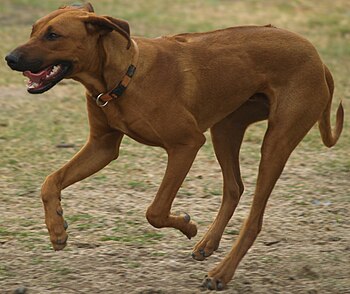| Rhodesian ridgeback head study (Photo credit: Wikipedia) |
Start early. You can train a ridgeback to be a guard dog at any age, but it is highly ideal to begin while he is still a puppy. He will be delighted in learning new things, and so dog training at the age of 6 months to a year old would be best.
Socialize. One of the best ways to get started with training a Rhodesian Ridgeback pup is to socialize them. Get them acquainted with their surroundings. Noises and distractions should be something that they can be indifferent to.
Schedule. Providing a set schedule allows both you and your Ridgeback to have a routine. Remember that Rhodesian Ridgebacks are highly energetic dogs that need a lot of exercises; running around the block or starting with a long walk can warm them up and help them focus more on training.
Sit! and others. It is always beneficial to start dog training with basic commands. "Sit", "down" and "stay" should be combined with clear hand signals for your ridgebacks to obey easily. Treats are also going to help greatly in getting them excited about dog training, but be cautious: you do not want your dog to be treat-dependent in following your orders.
Speak! Barking is considered "dog-speak" for canines, and in training your Ridgeback, you should be able to teach them to bark when someone arrives at your home. While this is almost like a dog's default reaction, it would be helpful to also teach them to stop when they are told. Start with praising the dog for barking and customize another command to let them know that the visitor is not a stranger.
Secure. Unlike other dogs, Ridgebacks are eager and expected to follow orders from their master. While it is tempting to show others that your dog is obedient, a good guard dog should be able to distinguish the master's commands and that of strangers.
Select. In the event that your dog needs to deal with a potential trespasser, only choose the parts of the body that your Rhodesian Ridgeback should attack. Extremities such as arms or legs are the most common, and dog training should also include the command "drop" to release the dog's mouth from the stranger.
Rhodesian Ridgeback training should not be so difficult if you just continue to be consistent, patient with them and quick to praise. Like any other dog, ridgebacks also need the love and warmth that comes with taking care of a pet. Dog training should be a fun bonding experience for you and him, no matter how aggressive and dangerous these guard dogs may seem to be.
Lea Mullins discusses all Rhodesian Ridgeback training as a Guard Dog. Learn more about Dog training, Walking your Dog without pulling on leash and more from TrainPetDog.com. Article Source: EzineArticles |




